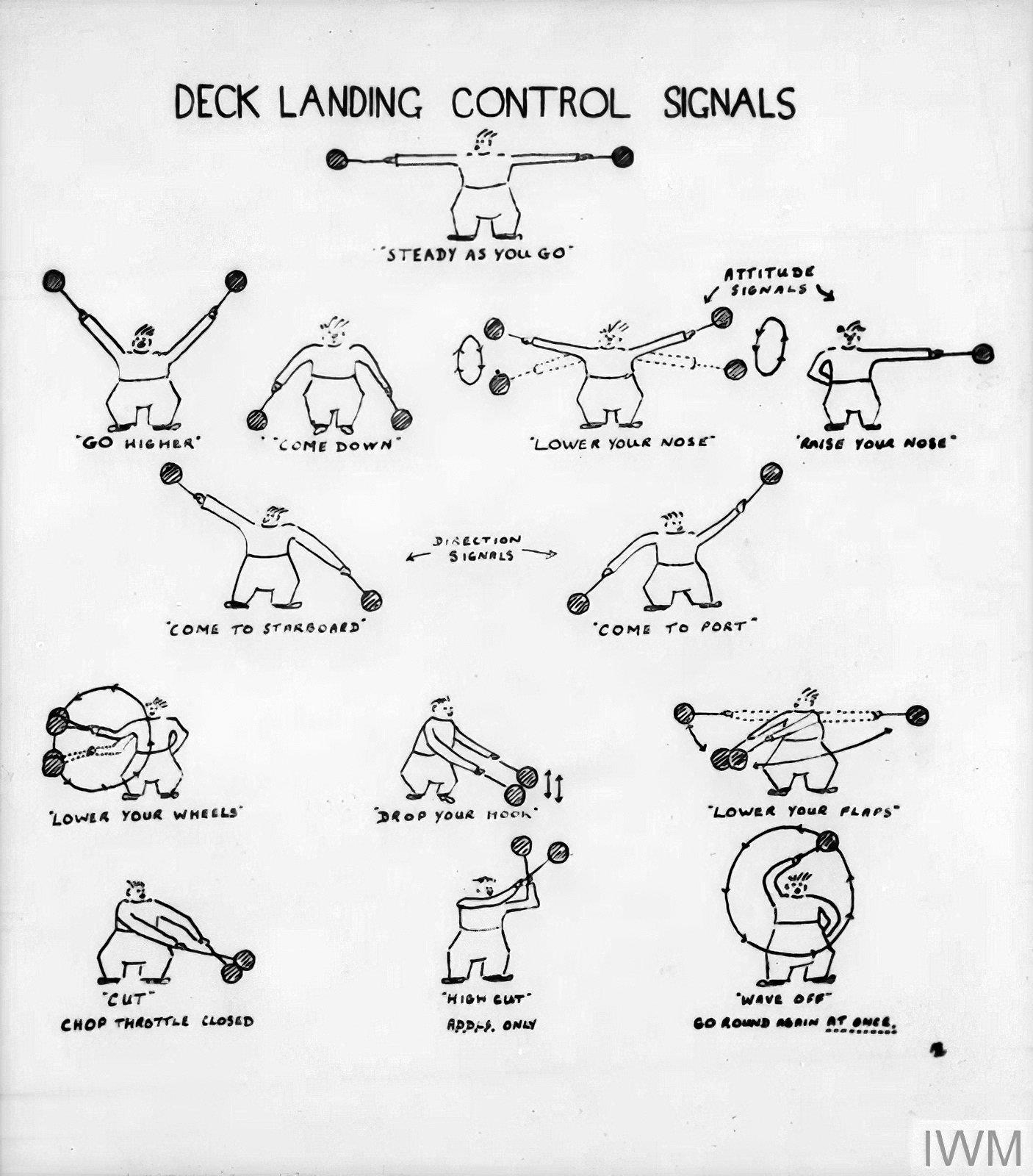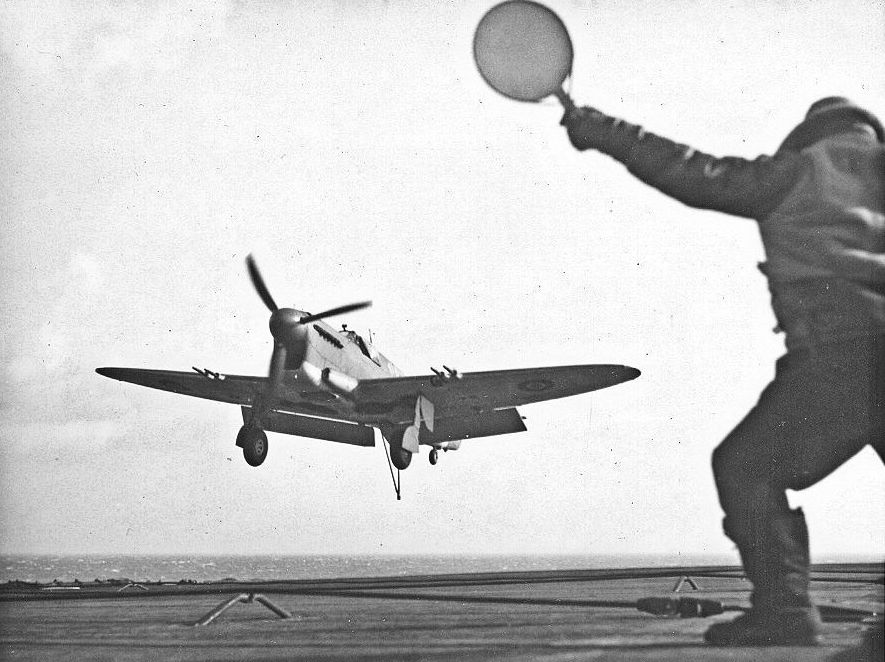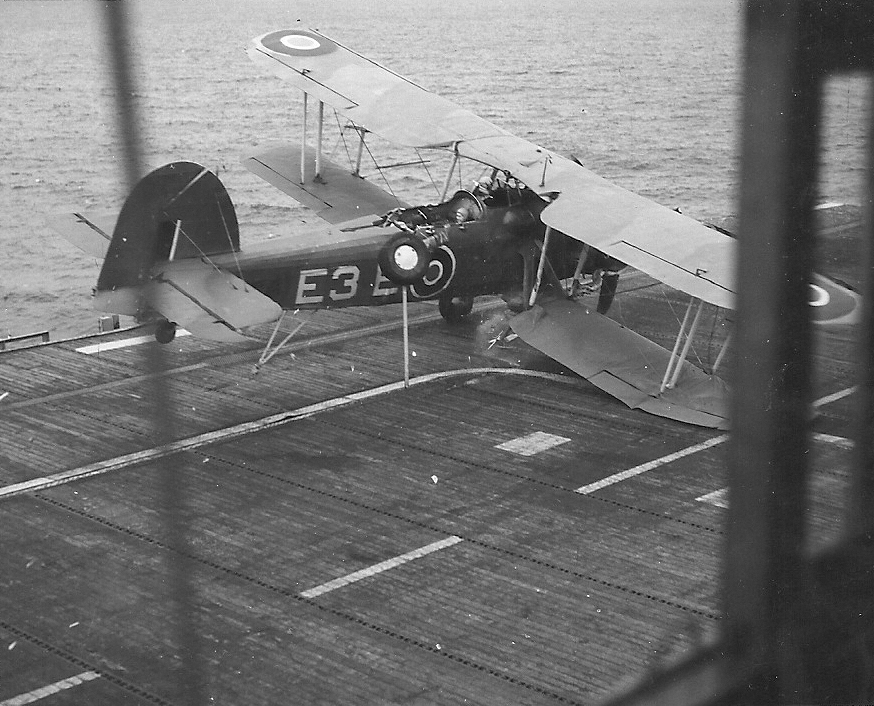



No. 731 squadron was formed at RNAS East Haven on December 5th 1943 for the training of Deck Landing Control Officers (DLCOs), Lt. Cdr (A) (P) K. Stilliard, RNVR in command. Initial squadron strength was thirteen pilots and the equipment issued was a mix of Swordfish Mk. I & II and Sea Hurricane Mk. IIb.

Officers manning 'HMS SPURIOUS MARK II' - a bus converted to resemble the island of an aircraft carrier used as part of the dummy carrier flight deck at RNAS East Haven. © IWM A 24702
The squadron joined two other squadrons at RNAS East Haven which formed the Deck Landing Training School, 767 DLT squadron and 769 Torpedo, bomber and reconnaissance (TBR) DLT squadron; the latter had provided DLCO training courses prior to the formation of 731 as a dedicated DLCO training squadron. 767 operated a similar collection of aircraft types as 731, but 769 specialised in the Barracuda from early 1944 as the TBR Course Part II.
Unlike the other two squadrons in the School 731 squadron pilots were not trainees, they were experienced flyers already qualified for carrier deck landing. They were tasked with flying continuous circuits and approaches to land on whichever runway was in use as the ‘Dummy Deck’, their approach being directed by the trainee DLCOs, or ‘Batsmen’ as they were colloquially known. This repetitive work earned them the nickname ‘Clockwork mice’. In an attempt to add more realism to the scenario a 1930s Albion bus was converted by the station staff to simulate the island of an aircraft carrier, this Dummy Carrier Island was given the nickname ‘H.M.S. Spurious’.

The signals used by the 'Batsman' to guide in aircraft onto the flight deck. © IWM A 27684
For most of the war candidates for Deck Landing Control Officer were experienced squadron pilots selected to receive three weeks intensive training, later though junior pilots were selected. The trainees had to learn the different signals used to communicate with the pilot using high visibility paddles during the day and illuminated one for night flying. These resembled tennis bats so the DLCO became known as “Bats”. Signals were given to warn if the approach was too high, too low, too fast or to lower the undercarriage or arrester hook if not already done, correct drift to port or starboard and keeping the wings level. These instructions were given until the final moment when the aircraft was over the dummy rounddown and committed to land. Should the pilot make an unsafe approach the batsman would ‘wave him off’ to return to the circuit for another approach. The prospective DLCOs also had to be familiar with the landing characteristics of the different aircraft types being operated in the Fleet Air Arm; some had restricted forward visibility on approach, both the American Corsair and the British Seafire had long noses. A straight in approach would result in the pilot being unable to see the Batsman and so required a completely different approach to the deck.
The ‘Dummy Deck’ was set up to simulate all the activities experienced on a real carrier flight deck, including an aircraft parking area into which pilots had to taxi after landing, the aircraft handling parties then their wings folded before being secured in the parking area. Likewise, aircraft required for flying were man handled out of the park and ranged on the ‘Dummy Deck’, their wings spread ready for take-off. Simulated crashes on deck were practiced to teach fire fighting and rescue techniques. The trainee DLCO attended short courses at the Aircraft Handling and Fire Fighting schools, both located on the station, receiving training in the handling of aircraft on deck, the spreading and folding of wings and fire fighting.
The culmination of the course was to perform the duties of the DLCO at sea on a n available carrier; with the arrival of the Auxiliary Aircraft Carriers there were dedicated Deck Landing Training (DLT) Carriers operating on both the east and west coast of Scotland. Escort carriers on DLT duty included: RAVAGER (Jan 44), KHEDIVE (Jun 44), RAJAH (Aug 44), RANEE (Nov 44), SPEAKER (Nov 44), SMITER (Jan - May - Apr 45), BATTLER (Jul – Sep 45). Lt. Cdr(A) (P) R. Pridman-Wippel RNVR assumed command on January 1st 1945.
The slow Swordfish Bi-plane was on squadron strength throughout the unit’s existence but other, mainly fighter types, were operated; in March 1944 a number of Fulmar Mk. IIs were received, followed by Seafire Mk. IIbs in May, and Corsair MK. II & III from June. An additional 7 pilots were appointed to the squadron around this time as the flying task increased, but had reduced to 14 by October 1944; many of the pilots were certified on several of the aircraft types. Firefly Mk I and NF. II Were received in December 1944 and finally the Barracuda Mk. II arrived in July 1945.
The squadron’s safety record was very good, most flying accidents occurred on, or on approach to the ‘Dummy Deck’, with others being crashes on deck happening during the afloat training sessions. Collisions on the ground were common; Sub-Lt A. C. Parry RNVR in Sea Hurricane P3706 taxied into Sea Hurricane Z4778 piloted by Sub-Lt B. F. O'Neill RNZNVR in the dummy deck range on March 2nd 1944. On June 9th 1944 Swordfish W5971 ('E3A’) piloted by Sub-Lt J. W. Johnson RNZNVR swung into Swordfish V4568 piloted by Sub-Lt M. H. Redrup RNVR in the dummy deck range when one chock was removed. A Barracuda, LS578 of 767 Squadron, was taxied into by Sub-Lt L. S. Watson RNZNVR in Swordfish NF261 on November 28th 1944. Another 767 Squadron Barracuda, P9670 was hit by Swordfish NF320 piloted by Sub-Lt B. E. Holford-Walker RNVR while moving on the runway on January 29th 1945. Another taxying incident involved Swordfish NES91 piloted by Sub-Lt J. H. H. Shell RNVR which ran into Swordfish NF247 ('E3C') stationery on the peritrack on February 28th 1945.

A DLCO 'bats' a Firefly into land on the deck of HMS SMITER, the approach is good, undercarriage, flaps and hook are down and the aircraft is approaching the rounddown.
Undercarriage failure also account for many crashes; this was one of the most common causes of landing crashes in the Fleet Air Arm as a whole, some RAF aircraft types in naval use were designed for grass airfields and their undercarriage often failed under the stress of landing on a pitching and rolling deck. The ‘Dummy Deck’ also broke undercarriages during the repetitive cycle of landings and take-offs; examples are Sea Hurricane V7301 on March 11th 1944 flown by Sub-Lt S. T. David RNVR which stalled just before touch down and landed heavily on the port undercarriage leg which collapsed. Sea Hurricane R4078 on June 29th 1944, and Swordfish W5987 two days later, suffered oleo leg collapses landing, both flown by Sub-Lt J. A. Robertson RNVR. The same pilot broke the undercarriage of Seafire MB358 ('E3W') on July 11th 1944. The undercarriage of Sea Hurricane P3667 flown by Sub-Lt A. H. G. Kynaston RNVR collapsed landing on August 11th 1944, a similar incident happened to Sub-Lt P. M. King landing in Fulmar X8553 on the 23rd. Sub-Lt F. A. Morris RNVR had the opposite experience in Barracuda BV801 on July 22nd 1945, his undercarriage collapse during take-off.
There were six crashes recorded, two involved fatalities.; The first was on January 25th 1944, Sea Hurricane AF946, flown by Sub-Lt B. F. O'Neill RNZNVR, suffered engine failure after take-off and he made a forced landing in a ploughed field, the aircraft nosed over, but the pilot was OK. On May 6th 1944 Fulmar X8752 also suffered engine failure after take-off and he made a forced landing resulting in a crash, the pilot Sub-Lt J. B. W. Broadbent RNVR was OK. Firefly Z2096 crashed in a potato field at Upper Wyndings, just a short distance west of Stonehaven, on November 11th 1944, the farmer and an Italian POW working on the farm were killed, the pilot Sub-Lt P. M. King survived. Another Firefly crash claimed the squadrons only aircrew fatality, Sub-Lt F. M. Batten RNZNVr was killed on December 5th 1944 landing in Firefly Z1903, the aircraft stalled on approach and hit the ‘Dummy Carrier Island’ Bus and caught fire killing the pilot. Water in the fuel caused Swordfish NF411 to suffer engine failure on December 19th 1944, the pilot Sub-Lt P. G. Comber made a forced landing but hit a hedge and the aircraft overturned, he was rescued OK. The new squadron C.O. Lt. Cdr R. Pridham-Wippell RNVR had a crash on June 28th 1945 making a flapless landing in Corsair JS885, he retracted the undercarriage before the aircraft could run off the runway into soft ground which would have caused the aircraft to overturn.

A Swordfish from 731 squadron crashes on the deck of HMS BATTLER during a session of DLCO qualifying. Possibly HS158 ('E3E') flown by Lt. R. H. Ayrton RNVR, which made a fast landing and had its undercarriage sheared off by the crash barrier on August 30th 1945. The starboard oleo leg and wheel can be seen flying rearwards. partly obscuring the last letter of the side code.
An increased demand for new DLCOs saw the squadron conducting dedicated sessions afloat to pass out courses. SMITER is recorded as providing the deck on May 2nd, with BATTLER on August 6th and again for a 5-day session on September 11th-15th.
There are 5 flying accidents recorded during sessions onboard HMS BATTLER; The first involved Swordfish HS158 ('E3E'), flown by Lt R. H. Ayrton RNVR on August 30th 1945, which made a fast landing and bounced into the barrier shearing off the undercarriage, the aircraft then went over the side into the sea, the pilot was rescued OK. The other 4 all involved Fireflies; on September 3rd Sub-Lt J. A. Robertson RNVR in Firefly NF.11 Z1971 entered no.s 2 & 3 barriers after his arrester hook jammed in the locked up position, also on that day he made a fast landing in Firefly NF.11 ZI973 ('E3P') caught No. 1 wire and his prop pecked the deck. On the 11th Firefly Z2019 flown by Lt CA Bevan (768 pilot?) hit the barrier and had its undercarriage torn off. On the last day of landings on BATTLER, September 15th, Sub-Lt D. Wormald in Firefly Z2116 ('E3J') also encountered the problem of the arrester hook being locked up, the aircraft was arrested by Nos. 2 & 3 barriers.
On October 25th 768 DLT squadron arrived from
RNAS Ballyhalbert to join the Deck Landing School; 731 squadron was disbanded on November 1st 1945 and its role absorbed into 767 & 768 DLT squadrons.
Content revised: 23 October 2022
Additional sources:

Motto: Circum Undique
'From everywhere around'
None
Barracuda II Jul - NOV 45
Corsair II/III Jun 44 - Nov 45
Firefly I Dec 44 - Nov 45
Fulmar II Mar - Jun 44
Seafire Ib May 44 - Feb 45
Seafire IIc Feb - Nov 45
Sea Hurricane Ib Dec 43 - Jun 44
Swordfish I/II Dec 43 - Nov 45
Swordfish III Nov 44 - Nov 45
Lt. Cdr (A) (P) K. Stilliard RNVR 15 Dec 1943
Lt. Cdr (A) (P) R. Pridman-Wippel RN 01 Jan1945
Squadron disbanded 01 November 1945
None
© 1999-2025 The Royal Navy Research Archive All Rights Reserved Terms of use Powered byW3.CSS
Press F5 to refresh the page after posting your comment or to hide the form
Watch the gun camera footage from his course Click here
Close
Comments (0)